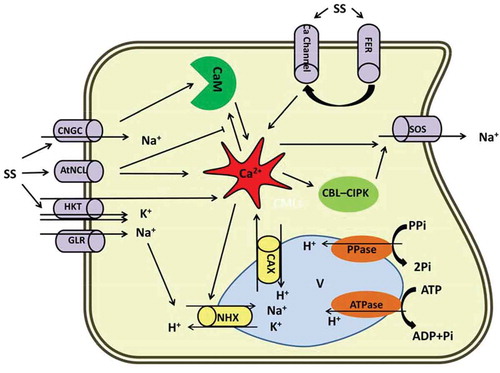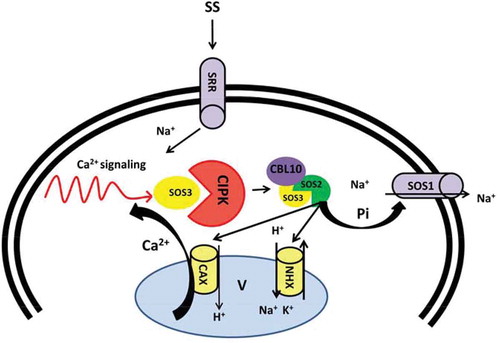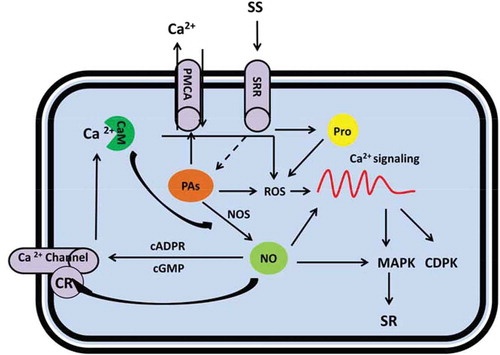Figures & data
Figure 1. Diagrammatic representation of the Ca2+ role in salt stress responses in plants. Prominent role of Ca2+ under salt has been proposed in this scheme. Na+ influx to the cytosol is mediated by CNGC, HKT, GLR and AtNCl. Na+ efflux is derived by SOS. NHX and CAX are involved in Na+/H+ and Ca2+/H exchanges through vacuolar membrane, respectively. Ca2+ in the center implicates the Na+ current either by direct interaction with ion channels or indirectly through Ca2+ related modules (CBL-CIPK and CaM). FER activates Ca2+ channels via unknown pathway and bears a transient Ca2+ signaling. AtNCL: Na+/Ca2+ exchanger-like protein, CAX: Vacuolar H+/Ca2+ antiporter, CNGS: Cyclic nucleotide gated channels, FER: FERONIA, GLR: Glutamate-activated channels, HKT: Na+ transporter, NHX: Vacuolar located Na+/H+ antiporters, SOS: Salt overly sensitive, SS: Salt stress.

Figure 2. Schema model of SOS pathway regulated by Ca2+ under saline shock. Ca2+ signaling triggered by salt stress activate SOS3 causes interaction with SOS2. SOS3/SOS2 complex activates SOS1 by direct phosphorylation driven by SOS2 and result in Na+ efflux. Alternatively, SOS2 regulates vacuolar channels (CAX and NHX) and balance Na+ vacuolar sequestration. CAX: Vacuolar H+/Ca2+ antiporter, CBL: Calcineurin B-like protein, CIPK: CBL-interacting protein kinase, NHX: Vacuolar located Na+/H+ antiporters, SOS: Salt overly sensitive, SS: Salt stress. SRR: Sal responsive receptors.

Figure 3. Metabolic scheme for regulation of salt stress responses by polyamines (PAs), nitric oxide (NO) and proline mediated by cytosolic Ca2+ signaling. Under salt stress, elevated PAs content affect Ca2+ level in the cell by either direct activation of PMCA and contributes to Ca2+ excursion (this will result in a steady state level of Ca2+ for normal metabolism in the cell); or indirectly by stimulation of NO and ROS production that results in downstream Ca2+ signaling. Similarly by salt shock, enhanced proline content influences the Ca2+ read out by ROS engagement; while NO is multiply associated with Ca2+ signaling comprising: direct manipulation of the Ca2+ signaling, effect on Ca2+ channels and regulation of MAPKs. CR: Cysteine residue, cGMP: Cyclic GMP, cADPR: Cyclic ADP ribose (cADPR), CaM: Calmodulin, CDPK: Ca2+ dependent protein kinases, MAPK: mitogen-activated proteins kinase, NO: Nitric oxide, PAs: Polyamines, PMCA: plasma membrane-Ca2+-ATPase, Pro: Proline, ROS: Reactive oxygen species, SR: Salt responses, SRR: Salt responsive receptors.

